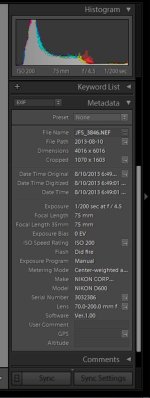I'm preparing for my first baby session with my D600 (continuing a monthly photo project with my daughter) and I was hoping for some advice on the best combination of settings and equipment to get truly black-appearing backdrops. With my old Canon "SLR-like" camera I found that either the subject looked dark or the backdrop looked charcoal grey instead of a true black and had to be darkened in Lightroom later. I never attempted studio portraits with my OM-1.
I've gotten some great shots with the D600 on light backgrounds, but somehow the blacks end up looking dull and flat instead of rich and inviting. So what is the best way to set things up to get a well-lit baby with a really rich, saturated black background without having to tweak it later?
If tweaking is necessary no matter what, should I be saving my images as RAW files and upgrading to LR5?
I use a large piece of black fleece as a backdrop. Should I try a different backdrop? I want to stick with black for continuity, but would a different material work better?
So far I have tried shooting indoors without flash in a room with lots of natural light (subject was too dark) and outdoors just after sunset (subject perfectly lit, but backdrop washed out). I'm considering switching to using studio lights since it rains here all summer and it's freezing in the winter... Would that help? I think I want continuous rather than strobe lighting (to avoid spooking baby), but would shoot-through umbrellas or stand-mounted soft boxes give better results? Where should they be positioned?
Sorry for the long post, and thanks in advance for the immense amount of wisdom that I'm sure is about to head my way!
I've gotten some great shots with the D600 on light backgrounds, but somehow the blacks end up looking dull and flat instead of rich and inviting. So what is the best way to set things up to get a well-lit baby with a really rich, saturated black background without having to tweak it later?
If tweaking is necessary no matter what, should I be saving my images as RAW files and upgrading to LR5?
I use a large piece of black fleece as a backdrop. Should I try a different backdrop? I want to stick with black for continuity, but would a different material work better?
So far I have tried shooting indoors without flash in a room with lots of natural light (subject was too dark) and outdoors just after sunset (subject perfectly lit, but backdrop washed out). I'm considering switching to using studio lights since it rains here all summer and it's freezing in the winter... Would that help? I think I want continuous rather than strobe lighting (to avoid spooking baby), but would shoot-through umbrellas or stand-mounted soft boxes give better results? Where should they be positioned?
Sorry for the long post, and thanks in advance for the immense amount of wisdom that I'm sure is about to head my way!


